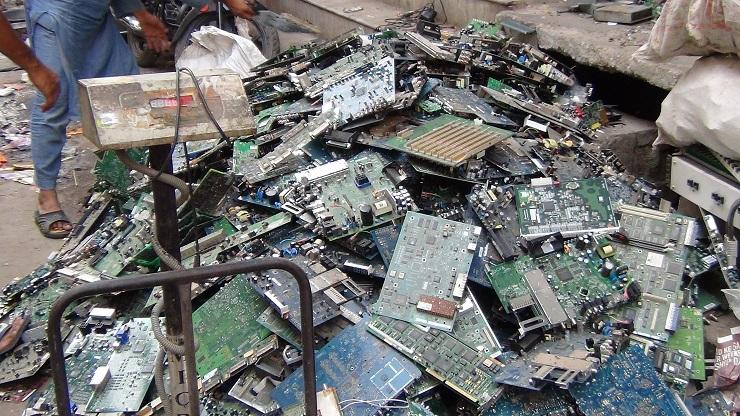ASIACALLING
Dealing with India’s mountains of e-waste
"In recent years India country has become known as a dumping ground for the world’s discarded electronics. There are now serious concerns about what impacts this will have on health and the environment"
Bismillah Geelani

India is the 5th largest generator of electronic waste or e-waste.
In recent years the country has been known as a dumping ground for the world’s discarded electronics. And the towers of toxic material keep building up.
As Bismillah Geelani reports, there are now serious concerns about what impacts this will have on health and the environment.
Transcript-
I’m here in Seemapuri, an area on the outskirts of Delhi, one of the areas in the city where electronic scrap is building up.
Walking through the narrow alleyways there are piles and piles of e-waste on either side. Old computer circuit boards, cables, keyboards, old mobile phone handsets, you name it, all kinds of technological junk.
Twenty-five year-old Mohammad Salman joined the trade a few years ago. Before that he used to repair mobile phones. But he makes more money dealing in e-waste.
“We collect it from all over the country, from waste pickers and other scrap dealers and then look for items that can be fixed. We keep them and then sell the rest of it to others.”
Salman continued, “since there are some precious metals in it so there is a demand for these things. We give it to bigger dealers and what they do with it is their business.”
Although Salman insists they only buy and sell the scrap, it looks like vendors here are doing more than just buying and selling.
Not far from Salman’s shop, some labourers are unloading a truck full of computer monitors and then breaking them into pieces with hammers.
I try to speak to them but their employer gets angry. He says they could get into trouble if they talk.
![]()
The area is also known as a place where e-waste is illegally recycled.
Further down the same lane, 35-year-old Ansar is burning a large circuit board with a blowtorch.
He then pulls some of its components out with a pair of pliers.
The acrid smell of smoke is suffocating. But Ansar looks unperturbed.
“Everyone has to do something for a living and this is our work. We take out those parts that can still be used and sell them to people who repair computers. Then we take out metals like copper and brass and finally we dip these boards into acid to get the gold that is there,” explains Ansar.
More from our climate change series Melting glaciers cause the Holy Ganges River to melt
Because of rapid economic growth, there has been as a phenomenal increase in the demand and production of electronic devices, such as computers, mobile phones and televisions.
Disposable electronics have become the norm. After a few years, phones and computers are tossed away and they end up in places like Seema Puri.
![]()
But often the e-waste is handled unsafely.
Most of the waste has a huge amount of toxicity, including lead, mercury, cadmium, bear phos and these all elements or chemicals are extremely harmful to human health and environment.
With such a large volume of waste, there are tonnes of chemicals present.
“When you deal with this in a manner which is rudimentary using a hammer, blow torch or acid you are releasing a large amount of toxins into the environment,” said Satish Sinha, the associate director of Toxics Link, a New Delhi-based environmental group.
According to a 2014 United Nations’ report India generates more than 2 million metric tons of e-waste each year.
That includes a huge amount of waste from abroad.
Until a few years ago, India along with several African countries was known as a global e-waste dumping ground.
That saw the government impose a ban on the importation of the toxic material.
Despite the ban e-waste still sneaks in and it’s becoming a huge burden, says Sinha.
“In developed economies the cost of treating waste is extremely high, also the environmental controls are very strict and robust. So you need to invest in technology, you need to be sure of what you are omitting and that’s why the cost of treating waste goes up in these countries,” Sinha explained.
More in our climate change series: Thailand's monitor lizards under threat
When it comes to developing economies the costs are almost negligible. So it becomes much easier for those countries to send their waste to developing economies and they sell the waste produced in developed countries.
![]()
Earlier this year, the government introduced new rules regarding the disposal of electronic waste, which pin more responsibility on manufacturers.
Environment Minister Prakash Javdekar explains, “the companies are now required to put in place a system through which they take back their products for recycling once they are discarded and this is the first time that we have set targets for them which they have to comply with.”
“They have to make these arrangements before they launch their product in the market,” stated Minister Javdekar.
Still environmentalists like Sinha are skeptical the new rules will work.
“In the previous law also, this provision was there, but the manufacturers are actually very reluctant to play their role.”
Sinha says it’s not just companies that to have be responsible, consumers too have to mind their waste.
More from our climate change series
In Kabul, where the rivers run dry
The long walk, Philippines climate justice activist Yeb Saño
Reverse osmosis plants saving lives in Pakistan's Thar Desert
- Bismillah Geelani
- India
- Climate change
- E waste
- climatelensasia
Komentar (0)
KBR percaya pembaca situs ini adalah orang-orang yang cerdas dan terpelajar. Karena itu mari kita gunakan kata-kata yang santun di dalam kolom komentar ini. Kalimat yang sopan, menjauhi prasangka SARA (suku, agama, ras dan antargolongan), pasti akan lebih didengar. Yuk, kita praktikkan!